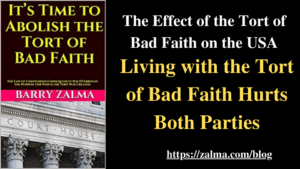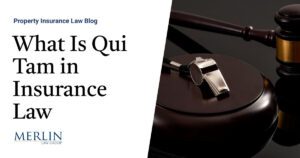The Effect of the Tort of Bad Faith on the USA

See the full video at https://rumble.com/v17jc3v-the-effect-of-the-tort-of-bad-faith-on-the-usa.html and at https://youtu.be/I-YF0EeL5CU
It is indisputable that in the 1950’s, 1960’s and 1970’s the insurance industry abused some insureds to avoid paying legitimate claims. Without a factual basis, insureds were accused of arson or other variations on insurance fraud. Indemnity payments were refused on the flimsiest of excuses. People were found to have diseases that only horses could catch. Disability payments were refused because an insured was wheeled in her wheelchair to church one day and, therefore, was not totally house-confined. Insureds were driven into bankruptcy when reasonable demands within policy limits were refused.
To stop this abuse, the courts of the state of California invented the tort of bad faith. It took a universal contract remedy and decided that the breach of an insurance contract without, what the court decided was proper, genuine or even fairly debatable reasons, was transferred from a contract breach into a new tort. Many other states have followed the lead.
Until the invention of the tort of bad faith all that an insured could collect from an insurer that wrongfully denied a claim were the benefits due under the policy. After the creation of the tort of bad faith, the courts allowed the insureds to collect, in addition, the entire panoply of tort damages, including punitive damages.
It worked. Insurers treated the insureds better. The threat of punitive damages made insurers wary of rejecting any claim. The creation of the tort of bad faith was in many ways a good thing for insurers and insureds. What the courts that created the tort of bad faith did not recognize was that it was also the key to Pandora’s box of abusive lawyers who found it to be a new profit center for their practices.
The law of unintended consequences struck with vigor. Lawyers flocked to every available court house to take advantage of the new tort.
Even if a claim against an insured is fairly debatable, an insurer is nonetheless obliged to engage in settlement discussions in an effort to relieve the insured from the burden and expense of litigation. [Summit Ins. Co. v. Stricklett, 199 A.3d 523 (R.I. 2019)] Therefore insurers must understand that even if the lack of coverage if fairly debatable or there is a genuine dispute it still may be held to protect the insured regardless of the lack of a duty to defend or settle. A decision from Rhode Island and other states that use the tort of bad faith to force insurers to provide benefits the policy did not promise to provide.
As Justice Kaus of the California Supreme Court noted back in 1985:
The problem is not so much the theory of the bad faith cases, as its application. It seems to me that attorneys who handle policy claims against insurance companies are no longer interested in collecting on those claims, but spend their wits and energies trying to maneuver the insurers into committing acts which the insureds can later trot out as evidence of bad faith. [White v. Western Title Ins. Co., 40 Cal. 3d 870, 710 P.2d 309, 221 Cal. Rptr. 509 (Cal. 12/31/1985)]
When an insurer is sued it could be charged with bad faith for taking, what the plaintiff and a court felt were too many depositions, unsuccessful motions for summary judgment, or failing to offer an appropriate amount at a settlement conference. It is now essential, before starting settlement negotiations, directly or in a settlement conference or mediation, as a result of the White v. Western Title Ins. Co. decision to have all parties waive the holding of the Supreme Court in White v. Western Title Ins. Co. before negotiations began.
The decision in White v. Western Title Ins. Co. has proved the adage that “the road to Hell is paved with good intentions.” Although the court had the apparent good intention of protecting an insured against what it saw as wrongful conduct by an insurer devastated the ability of insurers to defend themselves against unfounded bad faith law suits and encouraged more bad faith litigation.
Critics of White and opponents of the admission of litigation conduct as evidence of bad faith raise four arguments.
Sufficient Existing Protections: The trial judge, rules of civil procedure, and ethics rules protect insureds from improper insurer litigation conduct.
Relevance: The litigation conduct of an insurer’s lawyer is only marginally probative of the insurer’s claim handling; furthermore, the prejudice resulting from placing litigation tactics before a jury substantially outweighs the probative value of such evidence.
Chilling Effect: The possibility that an insurer’s litigation conduct may be admitted as evidence of bad faith has a “chilling effect” on an insurer’s defense.
Attorney Compromise: Attorneys for insurers will be unreasonably constrained in their advocacy and will be required continually to evaluate whether they will be advocates or witnesses at trial.
In J.B. Aguerre, Inc. v. American Guarantee & Liability Ins. Co. (1997) 59 Cal.App.4th 6, 68 Cal.Rptr.2d 837, the Court of Appeal affirmed a judgment of dismissal on demurrer, holding a liability insurer did not act unreasonably as matter of law in refusing to meet the plaintiff’s $2 million settlement demand, despite the alleged risk of exposing the insured to uncovered punitive liability. The insured’s alleged fear of his punitive exposure coerced him to contribute to a settlement out of duress.
Looking through the form of the transaction the California Court of Appeal recognized that looking to its “economic substance,” Justice Neal observed as follows:
What we have here, at bottom, is an effort by [the insured] to concoct a bad faith claim out of whole cloth … with the ‘ingenious assistance of counsel.’ … [The insured] has attempted to position itself to pursue a high stakes, bad faith case, seeking punitive damages, from which it hopes to emerge not only with the [underlying] claim disposed of at no cost to [the insured], but a profit as well in the form of damages recovered from [the insurer]. Bad faith litigation is not a game, where insureds are free to manufacture claims for recovery. Every judgment against an insurer potentially increases the amounts that other citizens must pay for their insurance premiums. (emphasis added) [See also, Dynamic Concepts, Inc. v. Truck Ins. Exchange, 71 Cal.Rptr.2d 882, 61 Cal.App.4th 999 (Cal.App. 4 Dist., 1998)]
The logarithmic growth of insurance fraud in the state of California, and other states that have allowed tort damages for bad faith breach of insurance contracts, may be directly traced, in part, to the judicial creation of the tort of bad faith. Before the tort of bad faith, insurers with a reasonable belief that an insured was presenting a fraudulent claim would refuse to pay it and file a suspected fraudulent claim report with the Department of Insurance Fraud Division or Fraud Bureau. Persons perpetrating the fraud would, in most cases, accept the refusal as a cost of doing business and went on to the next fraudulent claim.
After the recognition of the tort of bad faith, those who perpetrated fraudulent insurance claims that were denied went to lawyers instead. Suits for bad faith popped up like wild flowers in the desert after a rainstorm.
Juries, angered by insurers accusing their insureds of fraud, punished the insurers with multimillion dollar judgments. After each judgment, hundreds of cases settled (even though no monies were owed) for fear of being victims of the same out of control juries. Fraud units that had been instituted in the 70’s were disbanded in the late 80’s because of fear of punitive damage judgments and only reinstated after states passed statutes requiring insurers to maintain insurance fraud investigation units.
Insurers need to recognize that since the 1950’s when the tort of bad faith was created, courts more frequently, recognizing the abuse of the tort of bad faith, find that the a “fairly debatable” issue of law like the application of a private limitation of action provision of a policy will defeat both a breach of contract and a bad faith claim.

(c) 2022 Barry Zalma & ClaimSchool, Inc.
Barry Zalma, Esq., CFE, now limits his practice to service as an insurance consultant specializing in insurance coverage, insurance claims handling, insurance bad faith and insurance fraud almost equally for insurers and policyholders. He practiced law in California for more than 44 years as an insurance coverage and claims handling lawyer and more than 54 years in the insurance business. He is available at http://www.zalma.com and zalma@zalma.com.
Subscribe to Zalma on Insurance at locals.com https://zalmaoninsurance.local.com/subscribe.
Subscribe to Excellence in Claims Handling at https://barryzalma.substack.com/welcome.
Write to Mr. Zalma at zalma@zalma.com; http://www.zalma.com; http://zalma.com/blog; daily articles are published at https://zalma.substack.com. Go to the podcast Zalma On Insurance at https://anchor.fm/barry-zalma; Follow Mr. Zalma on Twitter at https://twitter.com/bzalma; Go to Barry Zalma videos at Rumble.com at https://rumble.com/c/c-262921; Go to Barry Zalma on YouTube- https://www.youtube.com/channel/UCysiZklEtxZsSF9DfC0Expg; Go to the Insurance Claims Library – https://zalma.com/blog/insurance-claims-library/
Like this:
Loading…
Related



